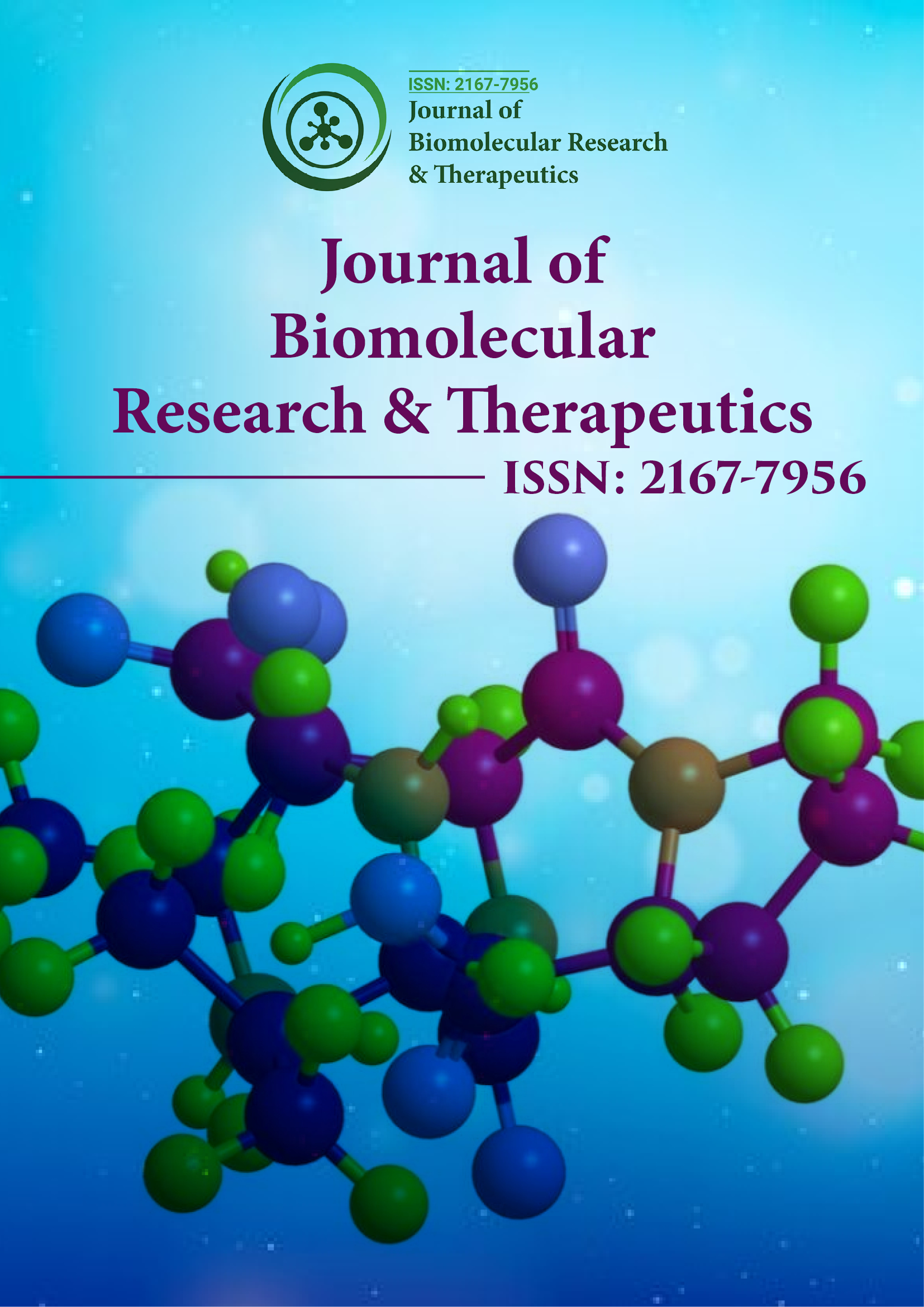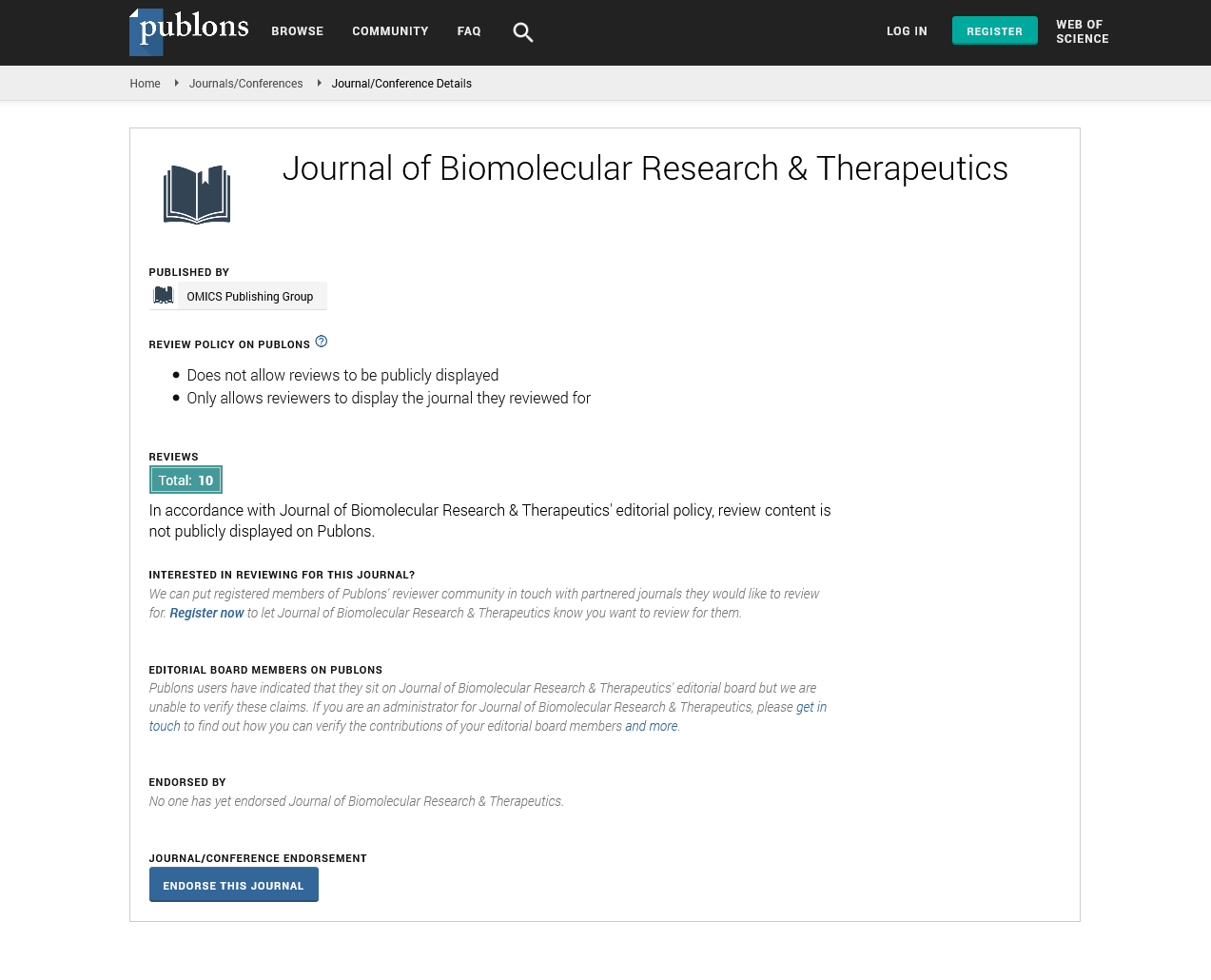Indexed In
- Open J Gate
- Genamics JournalSeek
- ResearchBible
- Electronic Journals Library
- RefSeek
- Hamdard University
- EBSCO A-Z
- OCLC- WorldCat
- SWB online catalog
- Virtual Library of Biology (vifabio)
- Publons
- Euro Pub
- Google Scholar
Useful Links
Share This Page
Journal Flyer

Open Access Journals
- Agri and Aquaculture
- Biochemistry
- Bioinformatics & Systems Biology
- Business & Management
- Chemistry
- Clinical Sciences
- Engineering
- Food & Nutrition
- General Science
- Genetics & Molecular Biology
- Immunology & Microbiology
- Medical Sciences
- Neuroscience & Psychology
- Nursing & Health Care
- Pharmaceutical Sciences
Opinion Article - (2025) Volume 14, Issue 1
Engineering Bispecific Antibodies to Block EGFR and MET in Drug Resistant Lung Cancer
Tomoya Saito*Received: 27-Jan-2025, Manuscript No. BOM-25-29314; Editor assigned: 29-Jan-2025, Pre QC No. BOM-25-29314; Reviewed: 12-Feb-2025, QC No. BOM-25-29314; Revised: 18-Feb-2025, Manuscript No. BOM-25-29314; Published: 26-Feb-2025, DOI: 10.35248/2167-7956.25.14.420
Description
Lung cancer remains one of the most lethal malignancies worldwide, with Non-Small Cell Lung Cancer (NSCLC) accounting for approximately 85% of all cases. Despite advances in targeted therapies, particularly against the Epidermal Growth Factor Receptor (EGFR), many patients eventually develop resistance, rendering these treatments ineffective. EGFR Tyrosine Kinase Inhibitors (TKIs) have shown remarkable clinical success in NSCLC patients harboring activating EGFR mutations. However, resistance inevitably arises, often due to secondary mutations such as T790M or bypass signaling mechanisms like amplification or overexpression of the MET proto-oncogene. The crosstalk between EGFR and MET signaling pathways not only drives tumor progression but also limits the efficacy of EGFR-targeted monotherapies. This challenge has led to the development of innovative strategies, such as bispecific antibodies (bsAbs), designed to simultaneously inhibit both EGFR and MET pathways, offering a promising therapeutic approach for overcoming drug resistance in lung cancer.
Bispecific antibodies are engineered molecules that can bind two different antigens simultaneously. In the context of drugresistant NSCLC, bsAbs are constructed to target both EGFR and MET receptors, aiming to suppress dual signaling pathways that contribute to tumor growth and therapeutic resistance. Unlike traditional monoclonal antibodies that are monospecific, bispecific antibodies provide the advantage of engaging multiple targets, increasing treatment efficacy while potentially reducing the emergence of compensatory resistance mechanisms. By blocking both EGFR and MET signaling, these antibodies can inhibit receptor dimerization, downstream kinase activation and key proliferative and survival pathways such as PI3K/AKT and MAPK/ERK.
The design and engineering of bsAbs for targeting EGFR and MET involve advanced protein engineering techniques to ensure high specificity, optimal pharmacokinetics and reduced immunogenicity. Various bispecific formats have been developed, including Dual-Variable Domain antibodies (DVD-Ig), tandem scFvs (single-chain variable fragments) and IgG-like bispecific constructs. Among these, IgG-like bsAbs are particularly attractive due to their structural similarity to natural antibodies, which supports better stability, long half-life and ease of manufacturing. The binding domains are selected and optimized to ensure that each arm of the bispecific antibody maintains high affinity to either EGFR or MET, without steric hindrance or functional compromise.
Preclinical studies have demonstrated that bsAbs targeting EGFR and MET effectively inhibit tumor cell proliferation and induce apoptosis in cell lines and xenograft models resistant to EGFR TKIs. These bsAbs block ligand dependent and independent activation of both receptors, reducing phosphorylation of downstream signaling proteins and impairing cancer cell survival. In particular, MET amplification — a known driver of resistance in EGFR-mutated tumors — is effectively counteracted by bsAbs that simultaneously neutralize both pathways. This dual blockade leads to more sustained and potent inhibition of oncogenic signaling compared to monotherapies or combination therapies using two separate antibodies, which may have differing pharmacodynamics and tolerability profiles.
Clinical development of EGFR/MET bsAbs is also underway, with several candidates showing encouraging results in early-phase trials. These include amivantamab, a fully human bispecific antibody targeting EGFR and MET, which has shown clinical activity in patients with EGFR exon 20 insertion mutations and in those who have progressed on prior EGFR TKI therapy. Amivantamab binds extracellular domains of EGFR and MET, inducing receptor degradation, blocking ligand binding and facilitating Antibody-Dependent Cellular Cytotoxicity (ADCC). Its bispecific nature enhances target engagement while minimizing redundant toxicity associated with separate EGFR and MET inhibitors. The success of amivantamab and similar agents underscores the therapeutic potential of bispecific antibodies in drug-resistant lung cancer and sets the stage for the development of next-generation bsAbs with improved efficacy and safety.
Despite the promise of bsAbs, several challenges remain in their clinical translation. These include the need for careful patient selection based on biomarker profiling, such as co-expression of EGFR mutations and MET amplification or overexpression. Additionally, the immunogenicity of engineered antibodies, their ability to penetrate solid tumors and the complexity of large-scale manufacturing require continued refinement. Future directions involve combining bsAbs with other therapeutic strategies such as immune checkpoint inhibitors or chemotherapy to enhance overall anti-tumor response. Moreover, emerging technologies like Antibody-Drug Conjugates (ADCs) or trispecific antibodies may offer further enhancements by delivering cytotoxic payloads or engaging immune effector functions in a more targeted manner.
In conclusion, engineering bispecific antibodies to concurrently target EGFR and MET represents a promising therapeutic innovation for managing drug-resistant lung cancer. By disrupting key compensatory signaling networks, bsAbs offer a more effective approach than monotherapies and may overcome some of the limitations of current targeted treatments. Continued advancements in antibody engineering, clinical testing and biomarker-driven patient stratification will be essential to fully realize the potential of bispecific antibodies in transforming the treatment landscape of lung cancer.
Citation: Saito T (2025) Engineering Bispecific Antibodies to Block EGFR and MET in Drug Resistant Lung Cancer. J Biol Res Ther. 14:420.
Copyright: © 2025 Saito T. This is an open access article distributed under the terms of the Creative Commons Attribution License, which permits unrestricted use, distribution and reproduction in any medium, provided the original author and source are credited.

